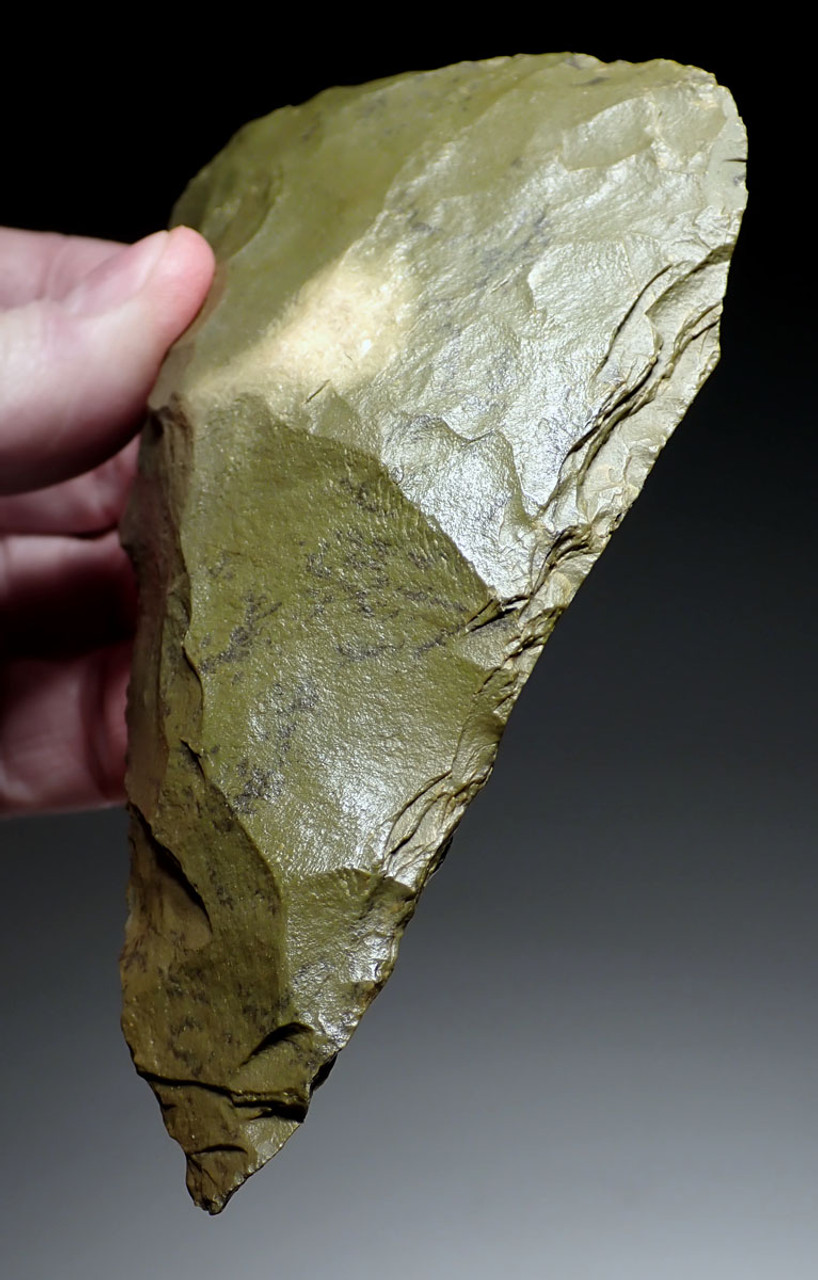Product Description
SEE MORE PREHISTORIC MIDDLE STONE AGE TOOLS
This incredibly rare African Middle Stone Age hand axe is a TRIANGULAR BIFACE HAND AXE. It was found in the Tenere region of the South Central Sahara Desert. What is most remarkable about this prehistoric work of art is that it was flaked out of prized green jasper that is most famously associated with prestige stone tool artifacts of the much later Tenerian Neolithic that date to tens of thousands of years later! NEVER before have we ever seen or know of a Paleolithic hand axe being made of this gem material. Not only does this put this hand axe into a class all its own, the workmanship in the flaking, shaping and PERFECT INTACT PRESERVATION WITH NO MODERN DAMAGE is what puts this piece into true 'investment-class' territory. It was no accident that in addition to the masterful workmanship and flaking by an extremely talented prehistoric artisan knapper, the white spot in the stone was purposely oriented to fall in the center of the axe body.
Since this stone was unknown in the Middle Stone Age of Africa in this region, it is without question, this object would have been the zenith of PRESTIGE objects to own. Imagine the drab colors of stone that predominantly populate the Earth, resulting in common earth-tone colors in all the stone tools of Prehistory. Then here comes an Archaic Homo sapiens carrying this remarkable gem! A hand axe of this workmanship and in this highly unusual color would be like owning the most expensive exotic automobile on the planet. Its incredible rarity over 50,000 years ago still holds true to this day, you will likely never seen another Paleolithic African hand axe made of this stone.
The entire hand axe shows expert flaking and shaping, with delicate secondary flaking around the perimeter to form exceptional symmetry and smoothness, where the grip is. One side has a deep flake removed in the center for the right hand thumb to fall into when held. A small flake on the opposite side was made for an opposing finger. This execution of a perfect ergonomic grip design just adds to the immeasurable rarity and beauty of this specimen. The long, masterfully-made triangular shape tapers to a perfectly preserved and unbroken tip. The entire surface has a naturally glossy surface due to 'desert varnish' which is a smooth, glossy surface layer consisting of iron oxide and manganese deposited over thousands of years by exposure to blowing desert sand.
This prize specimen comes from a private French collection formed in the 1960's -1970's, and was found on an exposed Middle Paleolithic site in the Tenere region of the South Central Sahara Desert. It dates to the Middle Stone Age (MSA), between 280,000 and 50,000 years ago. Coming from our personal "BEST OF THE BEST" private collection that we had built over 23 years of extensive international travel, this was the only green jasper hand axe we had ever encountered, or have known about in ANY collection. Over the years, we had been setting aside the absolute finest examples of African Middle Stone Age tools that we acquired. Today, you just do not find specimens like this and we enjoyed the collection but now, it is now time to let someone else be their proud steward. This collection fills just one large Riker box display flat so once they are gone, these will be gone forever.
HISTORY
The Middle Stone Age (or MSA) was a period of African prehistory between the Early Stone Age and the Late Stone Age. It is generally considered to have begun around 280,000 years ago and ended around 50–25,000 years ago. The beginnings of particular MSA stone tools have their origins as far back as 550–500,000 years ago and as such some researchers consider this to be the beginnings of the MSA. The MSA is often mistakenly understood to be synonymous with the Middle Paleolithic of Europe, especially due to their roughly contemporaneous time span, however, the Middle Paleolithic of Europe represents an entirely different hominin population, Homo neanderthalensis, than the MSA of Africa, which did not have Neanderthal populations. Additionally, current archaeological research in Africa has yielded much evidence to suggest that modern human behavior and cognition was beginning to develop much earlier in Africa during the MSA than it was in Europe during the Middle Paleolithic. The MSA is associated with both anatomically modern humans (Homo sapiens) as well as archaic Homo sapiens.
The stone tool technology in use during the Middle Stone Age (MSA) shows a mosaic of techniques. Beginning approximately 300 kya, the large cutting tools of the Achuelian are gradually displaced by Levallois prepared core technologies, also widely used by Neanderthals during the European Middle Paleolithic. As the MSA progresses, highly varied technocomplexes become common throughout Africa and include pointed artifacts, blades, retouched flakes, end and side scrapers, grinding stones, and even bone tools. However, the use of blades (associated mainly with the Upper Paleolithic in Europe) is seen at many sites as well. In Africa, blades may have been used during the transition from the Early Stone Age to the Middle Stone Age onwards. Finally, during the later part of the Middle Stone Age, microlithic technologies aimed at producing replaceable components of composite hafted tools are seen from at least 70 ka at sites such as Pinnacle Point and Diepkloof Rock Shelter in South Africa.
 US DOLLAR
US DOLLAR
 EURO
EURO
 AUSTRALIAN DOLLAR
AUSTRALIAN DOLLAR
 CANADIAN DOLLAR
CANADIAN DOLLAR
 POUND STERLING
POUND STERLING
























